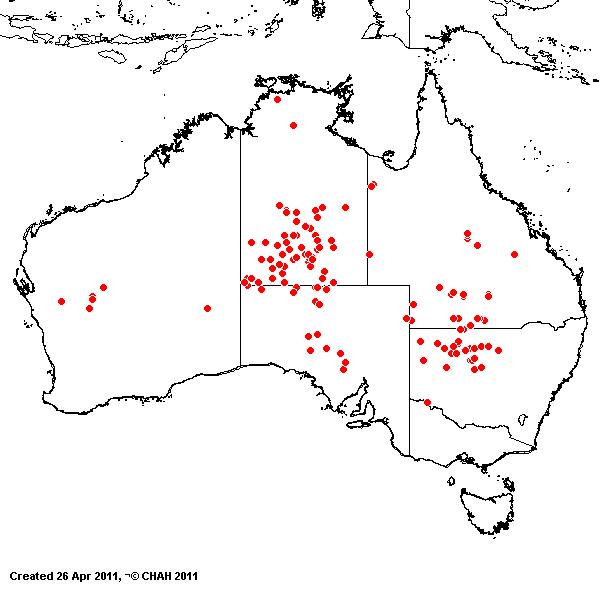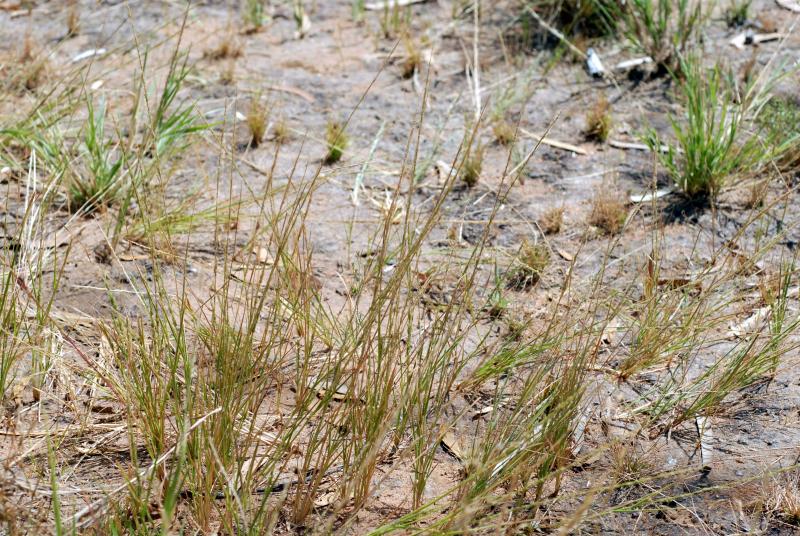Eragrostis kennedyae F. Turner. Proc.
Linn. Soc. New South Wales.
ser. 2, 8: 535 (1894).
Classification. (GPWG 2001) : Subfamily
Chloridoideae. Cynodonteae.
Type of Basionym or
Protologue Information: Australia:
New South Wales:
Wonnaminta Station, near Broken Hill, M.B. Kennedy s.n. .
Key references
(books and floras): [1952] C.A.Gardner, Flora of Western Australia 1
Gramineae (116), [1981] M.Lazarides in J.Jessop (ed)., Flora of
Central Australia (459), [2002] D.Sharp & B.K.Simon, AusGrass,
Grasses of Australia, [2006] J.Jessop, G.R.M.Dashorst, F.M.James, Grasses
of South Australia (373), [2008] S.W.L.Jacobs, R.D.B.Walley &
D.J.B.Wheeler, Grasses of New South Wales (252).
Illustrations:
[2005] K.Mallet (ed.), Flora of Australia 44B: Poaceae 3
(Fig. 72P-U), [2006] J.Jessop, G.R.M.Dashorst, F.M.James, Grasses of South
Australia (373, Fig. 303), [2008]
S.W.L.Jacobs, R.D.B.Whalley & D.J.B.Wheeler, Grasses of New South Wales,
4th edn (252).
Habit.
Perennial. Culms erect, stature slender to delicate, 12–76 cm tall. Ligule a
fringe of hairs, 0.3–0.5 mm long. Leaf-blades straight, flat or convolute, 3–6
cm long, 1–2.3 mm wide.
Inflorescence.
Inflorescence compound, a panicle or a panicle. Panicle lanceolate, 6.5–20 cm
long, 2.5–3.5 cm wide, contracted about primary branches.
Spikelets.
Spikelets pedicelled. Fertile spikelets many flowered, with at least 2 fertile
florets (3–6), comprising 3–6 fertile floret(s), with diminished florets at the
apex, ovate, laterally compressed, 1–2 mm long.
Glumes. Glumes
similar. Lower glume lanceolate, membranous, keeled, 1-keeled, 1 -nerved. Upper
glume lanceolate, 0.5 mm long, membranous, keeled, 1-keeled, 1 -nerved.
Florets.
Fertile lemma 0.7 mm long, keeled, 1–3 -nerved. Lemma apex muticous. Lodicules
present. Anthers 3.
Continental
Distribution: Australasia.
Australian
Distribution: Western Australia, Northern Territory, South Australia,
Queensland, New South Wales.
Western Australia: Dampier. Helms,
Ashburton, Austin. Northern Territory:
Darwin & Gulf, Central Australia North, Central
Australia South. South Australia:
North-western, Lake Eyre, Gairdner-Torrens
Basin. Queensland: Leichhardt, Gregory
North, Warrego. New South Wales:
North-Western Plains, North Far Western Plains.
Notes.
Distinguishing characters include inflated small spikelets similar in length
and width; trigonous caryopsis; persistent glumes; hairy culm internodes;
fragile straight rachilla; minute terminally exserted anthers; relatively wide
palea flaps; long panicles relative to plant; terminal floret in spikelet
vestigial; ovate-orbicular lemmas; ciliate ligule.
Apparently isolated in its relationships, but
resembling E. exigua in spikelet morphology.
Endemic;
occurs in W.A. near Meekatharra across to S of Warburton in the Great Victoria
Desert, throughout central N.T. and scattered S to L. Torrens in S.A. Also
occurs from Charleville, Qld to S of Louth, N.S.W. Seasonally wet habitats
(swamps, floodplains, dune swales, creek lines, claypans, seepage slopes,
gilgais) in grey, red or brown loams, clay loams and silty clays.; flowers
Jan.-May and July-Nov.; fruits Jan.-May and July-Nov.







